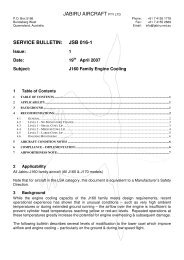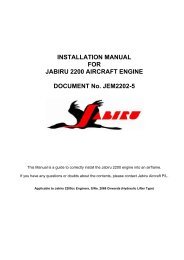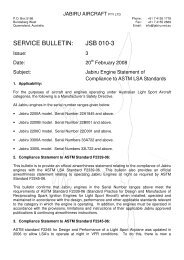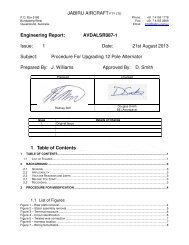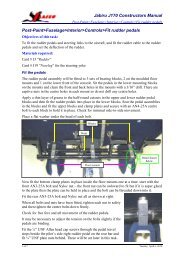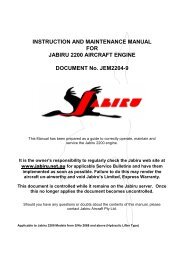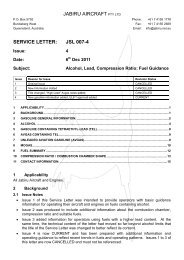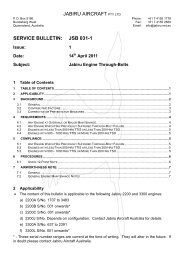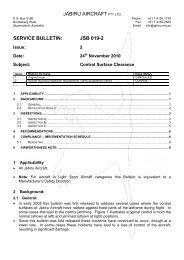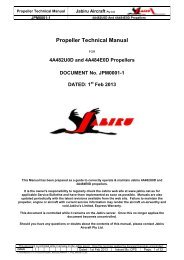JABIRU AIRCRAFT PTY LTD SERVICE LETTER: JSB 002-2
JABIRU AIRCRAFT PTY LTD SERVICE LETTER: JSB 002-2
JABIRU AIRCRAFT PTY LTD SERVICE LETTER: JSB 002-2
Create successful ePaper yourself
Turn your PDF publications into a flip-book with our unique Google optimized e-Paper software.
<strong>JABIRU</strong> <strong>AIRCRAFT</strong> <strong>PTY</strong> <strong>LTD</strong><br />
P.O. Box 5186 Phone: +61 7 4155 1778<br />
Bundaberg West Fax: +61 7 4155 2669<br />
Queensland, Australia. Email: info@jabiru.net.au<br />
<strong>SERVICE</strong> <strong>LETTER</strong>: <strong>JSB</strong> <strong>002</strong>-2<br />
Issue: 2<br />
Date: 2 nd April 2007<br />
Subject:<br />
Jabiru Engine Economy Tuning<br />
1 Table of Contents<br />
1 TABLE OF CONTENTS ...................................................................................................................................................1<br />
2 APPLICABILITY...............................................................................................................................................................2<br />
3 BACKGROUND:................................................................................................................................................................2<br />
4 CARBURETTOR OPERATION:.....................................................................................................................................3<br />
4.1 JETS & NEEDLE:...........................................................................................................................................................3<br />
4.2 FLOAT LEVEL: .............................................................................................................................................................5<br />
4.3 IDLE CIRCUIT INLET.....................................................................................................................................................5<br />
4.4 AIR DENSITY COMPENSATION .....................................................................................................................................6<br />
5 PROPELLER:.....................................................................................................................................................................6<br />
6 ENGINE INSTALLATION:..............................................................................................................................................6<br />
6.1 ENGINE CONDITION .....................................................................................................................................................7<br />
7 TUNING CHECK: .............................................................................................................................................................7<br />
7.1 LAMBDA RATIOS..........................................................................................................................................................7<br />
7.2 SPARK PLUGS...............................................................................................................................................................8<br />
7.3 PROPELLER / AIRFRAME COMPARISON: .......................................................................................................................8<br />
7.4 GENERAL NOTES..........................................................................................................................................................9<br />
7.4.1 When using spark plug colours to check tuning:....................................................................................................9<br />
8 FUEL BURN .......................................................................................................................................................................9<br />
9 INSTALLATION: ............................................................................................................................................................10<br />
10 RECOMMENDATIONS: ................................................................................................................................................10
Jabiru Service Letter: Jabiru Engine Economy Tuning<br />
JSL <strong>002</strong>-2 2nd April 2007<br />
2 Applicability<br />
All Jabiru Engines fitted with the economy tuning kit.<br />
The kit has been fitted as standard equipment from the following engine serial numbers:<br />
2200A – S/No. 1883 on<br />
2200B – All Engines.<br />
3300A – S/No. 722 on<br />
5100 – S/No. 24 on<br />
Note: For aircraft in Light Sport Aircraft categories this Letter is equivalent to a Manufacturer’s<br />
Safety Direction.<br />
3 Background:<br />
In December 2004 Jabiru Aircraft released a tuning kit for the Bing Carburettor used on our<br />
engines. This kit provided accurate tuning of the intake mixture to suit the engine loads,<br />
allowing fuel consumption to be reduced.<br />
The kit also produced a cleaner burn, slowing the formation of deposits in the combustion<br />
chamber which may have otherwise affected engine efficiency. Engines equipped with the<br />
tuning kit are also easier to tune to suit different airframe / propeller combinations. Power<br />
output is not affected.<br />
This ability to accurately tune the mixtures resulted in settings which work well in a normal<br />
Jabiru airframe, while the engine is in good condition & is using the recommended propeller.<br />
However, recent operational experience with the 2200 engine has shown that the mixture is<br />
affected by leaks in the head-cylinder seal as well as by leaks in the induction system. Different<br />
airframe and propeller combinations also significantly alter the mixture by changing the way the<br />
propeller load is applied to the engine<br />
The effects of these factors have not been well understood by some owners. In at least two<br />
cases, cylinder-to-head leaks have caused lean running, damaging exhaust valves & causing<br />
engine failures.<br />
This second Issue of the Economy Kit Service Letter provides more information to allow<br />
operators to better assess their carburetor settings. In addition, to make the system more<br />
tolerant of these leaning effects Jabiru Aircraft are revising the standard parts used in the 2200<br />
economy kit & introducing a recommended allowance on the jet sizes used on all engines.<br />
JSL<strong>002</strong>-2.doc Page 2 of 10
Jabiru Service Letter: Jabiru Engine Economy Tuning<br />
JSL <strong>002</strong>-2 2nd April 2007<br />
4 Carburettor Operation:<br />
4.1 Jets & Needle:<br />
Diaphragm spring<br />
Diaphragm<br />
Needle carrier<br />
Air density sense port<br />
Needle<br />
Idle circuit inlet aperture<br />
Atomiser<br />
Air density sense port<br />
Needle Jet<br />
Jet Carrier<br />
Idle Jet<br />
Main Jet<br />
Figure 1. Carburettor Cut Away Drawing<br />
The Bing altitude compensating carburettor used on Jabiru engines uses bowl float level and<br />
two main air circuits – the idle and the needle/main – to control the mixture. Both circuits use<br />
jets to meter the rate at which fuel is allowed to flow. The jets are small brass parts with<br />
precisely controlled openings (both the size of the opening and the shape surrounding the<br />
opening affect the fuel flow rate) which can be changed to adjust the engine mixture. The<br />
economy tuning kit contains new idle, needle and main jets, in addition to a new needle. Table<br />
JSL<strong>002</strong>-2.doc Page 3 of 10
Jabiru Service Letter: Jabiru Engine Economy Tuning<br />
JSL <strong>002</strong>-2 2nd April 2007<br />
1 shows the range of jet sizes available along with the standard parts supplied with the kit<br />
(unless requested otherwise).<br />
Table 1 – Kit Jet Sizes & Needle Part Numbers<br />
Item: 2200 Engine 3300 Engine 5100 Engine<br />
Economy<br />
Tuning Kit P/No.<br />
4A172A0N 4A171A0N 4A173A0N<br />
Idle Jet <br />
# 35 or # 45<br />
(# 35 Standard)<br />
# 45 # 35<br />
Needle Jet <br />
# 280 to # 285 # 285 to # 295 # 290 to # 295<br />
(#285 Standard) (# 290 Standard) (# 290 Standard)<br />
Main Jet <br />
# 220 to #235 # 255 to # 265 # 250 to # 255<br />
(# 225 Standard (# 255 Standard) (# 250 Standard)<br />
Needle <br />
Jabiru P/No.<br />
4A131A0D<br />
(2 notches on needle)<br />
Jabiru P/No.<br />
4A139A0D<br />
(3 notches on needle)<br />
Jabiru P/No.<br />
4A140A0D<br />
(5 notches on needle)<br />
Note that the needles for the different engines can be told apart by the number of shallow<br />
grooves machined above the taper (See Figure 2 below). The 2200 needle has two grooves,<br />
the 3300 three and the 5100 has five.<br />
The main and idle jets have simple fixed apertures, while the effective size of the needle jet<br />
aperture varies, depending on the diameter of the needle. Figure 2 below shows three different<br />
throttle settings in the needle jet and the corresponding difference in aperture. On the left is a<br />
low power setting, where the needle jet is nearly completely blocked by the needle. The middle<br />
throttle setting corresponds approximately to a high cruise power setting. The gap between the<br />
needle and the sides of the jet is much larger. The final setting corresponds approximately to<br />
wide open throttle. The needle jet is now effectively not there, and the amount of fuel flowing is<br />
controlled by the main jet (located upstream of the needle jet in this circuit).<br />
The shape of the taper of the needle controls the mixture at a given throttle setting. The original<br />
Bing needle has a nearly constant taper over it’s length which was designed to give a consistent<br />
mixture when fitted to an engine under a steady load (i.e. the load stays fairly constant with<br />
engine speed). The Jabiru needle by comparison has been optimized for use with a propeller,<br />
which puts a very non-linear load on the engine; to double the RPM of a propeller a lot more<br />
than double the power has to be applied.<br />
To achieve a good mixture with the type of load applied by a propeller, the Jabiru needle uses<br />
two-stage taper and a straight tip. The more gradual taper at the upper end of the needle gives<br />
a leaner mixture in cruise and at lower RPM where the propeller is using relatively little power,<br />
while the sharper taper at the lower end ramps up rapidly to a much richer mixture at higher<br />
power settings. The straight tip of the needle is used when the throttle is wide open and the<br />
engine’s mixture is being controlled by the main jet. This rich mixture at full power protects the<br />
engine from detonation.<br />
The transition from lean, cruise mixtures to richer full-power mixture will occur at around 2800 –<br />
3000 rpm on 4 and 6 cylinder engines, when fitted with an appropriate propeller. For most<br />
efficient operation, the transition must be above cruise rpm. The transition can clearly seen in<br />
the difference in exhaust temperatures.<br />
JSL<strong>002</strong>-2.doc Page 4 of 10
Jabiru Service Letter: Jabiru Engine Economy Tuning<br />
JSL <strong>002</strong>-2 2nd April 2007<br />
Jabiru Needle<br />
Needle Jet (cross<br />
section view)<br />
Jabiru 3300 needle<br />
shown, with 3 shallow<br />
grooves machined<br />
above taper.<br />
Slow, linear taper for<br />
cruise power & below.<br />
Steeper linear taper<br />
for transition<br />
between lean cruise<br />
mixture and rich,<br />
high power mixture.<br />
View looking<br />
through needle jet<br />
Parallel end for full<br />
power<br />
Needle Jet<br />
Needle<br />
Figure 2. Needle Jet (Jabiru Needle)<br />
4.2 Float Level:<br />
The float level affects the mixture through all air circuits. Lowering the float level will lean the<br />
mixture throughout the entire engine range, and raising the level will richen the mixture<br />
throughout the entire engine range. The float level setting works with the idle circuit to control<br />
the mixture at idle rpm. The idle circuit is always open, so changes to the idle jet and air<br />
passages will affect the mixture through the entire power range. Once above idle, the float level<br />
setting works with the needle/main jet circuit to control engine mixture.<br />
With the economy tuning kit installed, The float level must be set so that the floats cut off fuel<br />
flow when they are level.<br />
4.3 Idle Circuit Inlet<br />
As standard, the inlet aperture to the idle jet circuit is too small and does not flow enough air to<br />
work properly on Jabiru engines. To allow it to function as intended, the inlet aperture must be<br />
drilled out to 1.6mm diameter.<br />
JSL<strong>002</strong>-2.doc Page 5 of 10
Jabiru Service Letter: Jabiru Engine Economy Tuning<br />
JSL <strong>002</strong>-2 2nd April 2007<br />
4.4 Air Density Compensation<br />
At higher altitudes where the air is thinner less fuel must be added to the intake charge to give<br />
the proper mixture, so while the effective air/fuel mixture remains the same, the amount of fuel<br />
being used is reduced. The altitude compensating carburettor uses an air density compensation<br />
system to maintain a constant mixture at different altitudes. This system does not vary the<br />
mixture during flight (such as leaning the mixture at cruise) – the mixture is controlled by the<br />
shape of the needle and the sizes of the jets.<br />
The carburettor uses sense ports inside the carburettor inlet and a pressure sense tube to<br />
maintain a constant mixture. For the system to work properly, the ports inside the inlet must not<br />
be blocked (which can happen if bunched-up SCAT hose is attached directly to the carburettor<br />
inlet) and the sensor tube must be installed correctly as detailed in the engine installation<br />
manual.<br />
5 Propeller:<br />
The shape of the needles that have been developed for the 4 and 6 cylinder engines are<br />
tailored specifically for use with a propeller that meets the following requirements:<br />
i. Minimum static RPM during ground run-up: 2800<br />
ii. Maximum in-flight rpm between 3150 – 3300 rpm.<br />
8 Cylinder propellers must meet the following requirements:<br />
i) Minimum static RPM during ground run-up: 2400*<br />
ii) Maximum in-flight rpm between 2950 – 3100 rpm.<br />
* When using a coarse, fixed pitch propeller.<br />
Using a propeller which has operating RPM’s lower than those listed above with the standard<br />
Jabiru economy kit will result in a lean mixture and, in extreme cases, engine damage. While it<br />
is possible to adapt the mixture to suit a propeller which does not meet these requirements, the<br />
engine will be operating outside of it’s preferred RPM range and it is very strongly<br />
recommended by Jabiru that the propeller be modified or replaced by one more appropriate.<br />
The effect of different propeller and airframe combinations is outlined in Section 7.3 below.<br />
These effects must also be considered if a variable propeller is to be used.<br />
In general, when using a Jabiru engine on a non-standard airframe or with a non-standard<br />
propeller, it is strongly recommended that the suitability of the new tuning be checked. Refer to<br />
Section 7 below for details.<br />
6 Engine Installation:<br />
In installations where the engine is operating without cowls in very low ambient temperatures<br />
(less then 5°C or 41°F) the induction pipes for the engine are cooled to a very low temperature<br />
by airflow. This can lead to the air/fuel mixture condensing on the insides of the pipes, which<br />
reduces the concentration of fuel in the intake charge and leads to rough, lean running. This<br />
JSL<strong>002</strong>-2.doc Page 6 of 10
Jabiru Service Letter: Jabiru Engine Economy Tuning<br />
JSL <strong>002</strong>-2 2nd April 2007<br />
problem can be addressed by richening the fuel mixture (using larger needle & main jets) or by<br />
shrouding the induction pipes so that they are maintained at a warmer temperature by the<br />
engine’s heat.<br />
In general, all engines using the economy kit should be warmed in accordance with the aircraft’s<br />
operating manuals before flight.<br />
6.1 Engine Condition<br />
Any leaks in the induction system between the carburetor and the cylinders will lean the mixture<br />
and can cause valve or piston damage. In addition, if the head-to-cylinder seal degrades this<br />
can also result in lean running.<br />
Refer to the current Jabiru Engine manuals for servicing requirements. At the time of writing,<br />
the manuals require head bolt tension to be checked after the first 10 hours of running since the<br />
head has been fitted, then at 50 hours in service, and at an interval of 50 hours thereafter.<br />
Maintaining the correct tension in these bolts will ensure the condition of the head-cylinder seal.<br />
In addition, during scheduled maintenance care should be taken to inspect the induction tract &<br />
check for degrading seals or signs of air leaks.<br />
7 Tuning Check:<br />
7.1 Lambda Ratios<br />
There are several methods to check the engine tuning. The best way is to use a portable<br />
Lambda Meter system to check the exhaust gasses to find the air/fuel ratio throughout the<br />
operating range. The table below gives appropriate target mixtures for the Jabiru engine:<br />
Table 2.Target Lambda Probe Readings / Air/Fuel Ratios<br />
Power Range Lambda Probe Reading Fuel / Air Mix<br />
Idle 0.75 - 0.85<br />
Mid-Range / Cruise 0.9 – 0.99 14 : 1 – 14.7 : 1<br />
Above 70% Power No more than 0.8 11.5 : 1<br />
If an exhaust probe system is not available, the mixture can be checked using an EGT gauge.<br />
The gauge must be installed correctly, with the temperature sender located 120mm from the<br />
face of the exhaust port. The following table shows allowable EGT’s for the Jabiru engine.<br />
Preferred target EGT values are also given.<br />
Table 3. Allowable EGT Range<br />
Power Range EGT Allowance Preferred Target EGT<br />
Mid-Range / Cruise<br />
680 – 720°C<br />
680°C<br />
(1256 – 1328°F )<br />
1256°F<br />
Above 70% Power<br />
640 – 680°C<br />
640°C<br />
(1184 – 1256°F)<br />
1184°F<br />
JSL<strong>002</strong>-2.doc Page 7 of 10
Jabiru Service Letter: Jabiru Engine Economy Tuning<br />
JSL <strong>002</strong>-2 2nd April 2007<br />
7.2 Spark Plugs<br />
When running the engine on AVGAS, the colour of the spark plug insulator and the colour of the<br />
exhaust pipes can also provide an indication of mixture. An engine that is running well will have<br />
dark tan coloured spark plug insulators and an exhaust pipe that is between light tan and grey in<br />
colour. Both plug and exhaust colour are general indicators only and should only be used as a<br />
backup check on tuning to confirm the readings of the exhaust gas probe or EGT. Engines<br />
burning unleaded fuel will generally have darker plug and exhaust colours. It is generally not<br />
possible to judge the engine’s tuning by plug or exhaust colour when using unleaded fuel.<br />
Figure 3. Spark Plug Insulator Colour<br />
7.3 Propeller / Airframe Comparison:<br />
Figure 4 is a graph which shows three curves for Lambda Ratio vs RPM. The curve for the std<br />
J160-C is quite flat up to 2850 RPM, then quickly changes to a full-rich mixture for higher power<br />
settings. The other two curves show two flights of a different model Jabiru – a UL 500<br />
(“Calypso” in some markets). The UL uses the same engine as the J160-C, but has a larger<br />
wingspan and, in this particular aircraft, a propeller with a much higher pitch. The larger<br />
wingspan gives higher drag at high speed, while the larger propeller increases overall engine<br />
load.<br />
The “UL 500 1” curve shows the Lambda Ratios for the standard economy kit, while the “UL 500<br />
2” curve is for the same aircraft when fitted with larger jets. The effect of the different propeller<br />
can be seen as the engine is under higher load at lower RPM, resulting in a leaner mixture. The<br />
airframe difference appears at higher speeds (cruise speed & above) where the mixture enters<br />
the transfer region from lean to rich at a lower RPM and the mixture at full power is not as rich<br />
as on the standard aircraft. The changes shown changed fuel consumption at cruise from<br />
13L/hr to 15L/hr.<br />
JSL<strong>002</strong>-2.doc Page 8 of 10
Jabiru Service Letter: Jabiru Engine Economy Tuning<br />
JSL <strong>002</strong>-2 2nd April 2007<br />
1.1<br />
1<br />
Difference caused by<br />
changing from a #220<br />
main jet to a #235.<br />
0.9<br />
Lambda Ratio<br />
0.8<br />
0.7<br />
Std J160-C<br />
UL500 2<br />
UL500 1<br />
0.6<br />
0.5<br />
0.4<br />
2500 2600 2700 2800 2900 3000 3100<br />
RPM<br />
Figure 4. Lambda Ratio Comparison<br />
7.4 General Notes<br />
• The following assume a fixed-pitch propeller & conventional airframe are used. Variable<br />
propellers and variable drag (such as found with a retractable undercarriage) may<br />
significantly vary results.<br />
• When changing propellers: coarser pitch gives leaner mixture throughout RPM range.<br />
• During ground run-ups at 2000 RPM the engine mixture will be the same as at 2000<br />
RPM in the air.<br />
• Full power run-ups on the ground give engine mixture similar to full power in the air.<br />
7.4.1 When using spark plug colours to check tuning:<br />
• After a long descent at low power settings the spark plug colours may show a lean<br />
mixture. This is normal & not indicative of engine mixture in powered flight.<br />
• Always minimize the running time between running the engine at the mixture point you<br />
want to check and the time when you see the spark plugs (i.e. avoid prolonged taxiing).<br />
8 Fuel burn<br />
• Consumption for the 4 cylinder engine approximately 15-16 Litres per hour at 2850 RPM<br />
• Consumption for the 6 cylinder engine approximately 23-25 Litres per hour at 2850 RPM<br />
Note: Figures for engines installed in Jabiru airframes, with Jabiru propellers<br />
• Consumption for the 8 cylinder engine is approximately 30-31 Litres per hour when fitted<br />
in a Van’s RV-6, with a Sensenich propeller, cruising at 2600 rpm.<br />
JSL<strong>002</strong>-2.doc Page 9 of 10
Jabiru Service Letter: Jabiru Engine Economy Tuning<br />
JSL <strong>002</strong>-2 2nd April 2007<br />
9 Installation:<br />
Kits are available from Jabiru Aircraft which contain all of the parts required and come with<br />
comprehensive instructions.<br />
It should be noted that after installing the kit, the “feel” of the engine may change, seeming<br />
slightly harsher or just different. This is due to the more efficient combustion, and providing the<br />
mixture and EGT’s check within the acceptable range there will be no problem with the engine.<br />
Depending on the idle mixture, the engine will be harder to start from cold without choke due to<br />
the leaner mixture. Generally, with the economy tuning kit fitted and working properly, choke will<br />
be needed every time the engine is started from cold.<br />
10 Recommendations:<br />
While installation of the new tuning is optional, it has the benefits of maintaining a cleaner<br />
combustion chamber (including rings and valve seats) in addition to reducing fuel consumption.<br />
Owners of aircraft fitted with older economy kits which use jets smaller than those detailed<br />
above must assess their tuning & increase jet sizes if they decide their current mixtures are too<br />
lean.<br />
JSL<strong>002</strong>-2.doc Page 10 of 10





